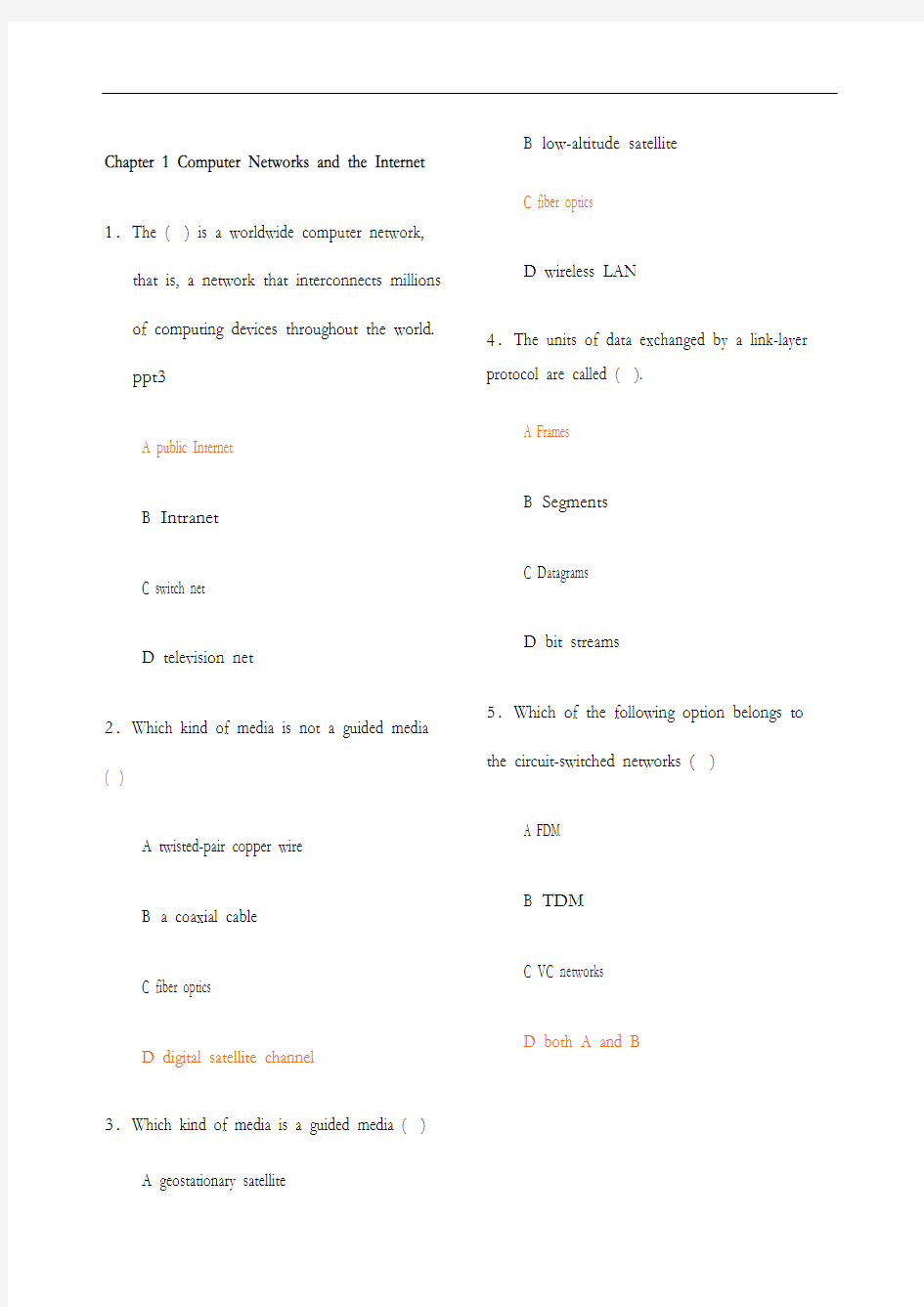

计算机网络英文题库附
答案c h a p t e r精编
W O R D版
IBM system office room 【A0816H-A0912AAAHH-GX8Q8-GNTHHJ8】
Chapter 1 Computer Networks and the Internet 1.The ( ) is a worldwide computer network, that is, a network that interconnects millions of computing devices throughout the world.
ppt3
A public Internet
B Intranet
C switch net
D television net
2.Which kind of media is not a guided media ( )
A twisted-pair copper wire
B a coaxial cable
C fiber optics
D digital satellite channel
3.Which kind of media is a guided media ( )
A geostationary satellite
B low-altitude satellite
C fiber optics
D wireless LAN
4.The units of data exchanged by a link-layer protocol are called ( ).
A Frames
B Segments
C Datagrams
D bit streams
5.Which of the following option belongs to the circuit-switched networks ( )
A FDM
B TDM
C VC networks
D both A and B
6.( )makes sure that neither side of a
connection overwhelms the other side by
sending too many packets too fast.
A Reliable data transfer
B Flow control
C Congestion control
D Handshaking procedure
7.( ) means that the switch must receive the entire packet before it can begin to transmit the first bit of the packet onto the outbound link.
A Store-and-forward transmission
B FDM
C End-to-end connection
D TDM
8.Datagram networks and virtual-circuit networks differ in that ( ).
A datagram networks are circuit-switched
networks, and virtual-circuit networks are
packet-switched networks.
B datagram networks are packet-switched
networks, and virtual-circuit networks are
circuit-switched networks.
C datagram networks use destination
addresses and virtual-circuit networks use
VC. numbers to forward packets toward
their destination.
D datagram networks use VC. numbers
and virtual-circuit networks use destination
addresses to forward packets toward their
destination.
9.In the following options, which one is not a guided media ( )
A twisted-pair wire
B fiber optics
C coaxial cable
D satellite
10.Processing delay does not include the time to ( ).
A examine the packet’s header
B wait to transmit the packet onto the link
C determine where to direct the packet
D check bit-error in the packet
11.In the following four descriptions, which one is correct ( )
A The traffic intensity must be greater
than 1.
B The fraction of lost packets increases as
the traffic intensity decreases.
C If the traffic intensity is close to zero,
the average queuing delay will be close to
zero.
D If the traffic intensity is close to one, the
average queuing delay will be close to one.12.The Internet’s network layer is
responsible for moving network-layer
packets known as ( ) from one host to
another.
A frame
B datagram
C segment
D message
13.The protocols of various layers are called ( ).
A the protocol stack
B TCP/IP
C ISP
D network protocol
14.There are two classes of packet-switched networks: ( ) networks and virtual-circuit
networks.
A datagram
B circuit-switched
C television
D telephone
15.Access networks can be loosely classified into three categories: residential access,
company access and ( ) access.
A cabled
B wireless
C campus
D city area
Question 16~17
Suppose, a is the average rate at which packets arrive at the queue, R is the transmission rate, and all packets consist of L bits, then the traffic intensity is ( 16 ), and it should no greater than ( 17 ).
16.A LR/a
B La/R
C Ra/L
D LR/a 17.A 2
B 1
C 0
D -1
18.In the Internet, the equivalent concept to end systems is ( ).
A hosts
B servers
C clients
D routers
19.In the Internet, end systems are connected together by ( ).
A copper wire
B coaxial cable
C communication links
D fiber optics
20.End systems access to the Internet through its ( ).
A modems
B protocols
C ISP
D sockets
21.End systems, packet switches, and other pieces of the Internet, run ( ) that control
the sending and receiving of information
within the Internet.
A programs
B processes
C applications
D protocols
22.There are many private networks, such as many corporate and government networks,
whose hosts cannot exchange messages
with hosts outside of the private network.
These private networks are often referred
to as ( ).
A internets
B LAN
C intranets
D WAN
23.The internet allows ( ) running on its end systems to exchange data with each other.
A clients applications
B server applications
C P2P applications
D distributed applications
24.The Internet provides two services to its distributed applications: a connectionless
unreliable service and () service.
A flow control
B connection-oriented reliable
C congestion control
D TCP
25.It defines the format and the order of messages exchanged between two or more
communicating entities, as well as the
actions taken on the transmission and/or
receipt of a message or other event. The
sentence describes ( ).
A Internet
B protocol
C intranet
D network
26.In the following options, which does not define in protocol ( )
A the format of messages exchanged
between two or more communicating
entities
B the order of messages exchanged
between two or more communicating
entities
C the actions taken on the transmission of
a message or other event
D the transmission signals are digital
signals or analog signals
27.In the following options, which is defined in protocol ( )
A the actions taken on the transmission
and/or receipt of a message or other
event
B the objects exchanged between communicating entities
C the content in the exchanged messages
D the location of the hosts
28.In the following options, which does not belong to the network edge ( )
A end systems
B routers
C clients
D servers
29.In the following options, which belongs to the network core ( )
A end systems
B routers
C clients
D servers
30.In the following options, which is not the bundled with the Internet’s connection-
oriented service
( )
A reliable data transfer
B guarantee of the transmission time
C flow control
D congestion-control
31.An application can rely on the connection to deliver all of its data without error and
in the proper order. The sentence
describes ( ).
A flow control
B congestion-control
C reliable data transfer
D connection-oriented service
32.It makes sure that neither side of a
connection overwhelms the other side by
sending too many packets too fast. The
sentence describes ( ).
A flow control
B congestion-control
C connection-oriented service
D reliable data transfer
33.It helps prevent the Internet from entering
a state of gridlock. When a packet switch
becomes congested, its buffers can
overflow and packet loss can occur. The
sentence describes ( ).
A flow control
B congestion-control
C connection-oriented service
D reliable data transfer
34.The Internet’s connection-oriented service has a name, it is ( ).
A TCP
B UDP
C TCP/IP
D IP 35.In the following options, which service does not be provided to an application by TCP( )
A reliable transport
B flow control
C video conferencing
D congestion control
36.The Internet’s connectionless service is called ( ).
A TCP
B UDP
C TCP/IP
D IP
37.In the following options, which does not use TCP(
)
A SMTP
B internet telephone
C FTP
D HTTP
38.In the following options, which does not use UDP( )
A Internet phone
B video conferencing
C streaming multimedia
D telnet
39.There are two fundamental approaches to building a network core, ( ) and packet
switching.
A electrical current switching
B circuit switching
C data switching
D message switching
40.In ( ) networks, the resources needed along a path to provide for
communication between the end system
are reserved for the duration of the
communication session.
A packet-switched
B data-switched
C circuit-switched
D message-switched
41.In ( ) networks, the resources are not reserved; a session’s messages use the
resources on demand, and as a
consequence, may have to wait for access
to communication link.
A packet-switched
B data-switched
C circuit-switched
D message-switched
42.In a circuit-switched network, if each link has n circuits, for each link used by the
end-to-end connection, the connection
gets ( ) of the link’s bandwidth for the
duration of the connection.
A a fraction 1/n
B all
C 1/2
D n times
43.For ( ), the transmission rate of a circuit is equal to the frame rate multiplied by the
number of bits in a slot.
A CDMA
B packet-switched network
C TDM
D FDM 44.( ) means that the switch must receive the entire packet before it can begin to
transmit the first bit of the packet onto the
outbound link.
A Queuing delay
B Store-and-forward transmission
C Packet loss
D Propagation
45.The network that forwards packets
according to host destination addresses is
called ( ) network.
A circuit-switched
B packet-switched
C virtual-circuit
D datagram
46.The network that forwards packets
according to virtual-circuit numbers is
called ( ) network.
A circuit-switched
B packet-switched
C virtual-circuit
D datagram
47.In the following entries, which is not a kind of access network(
)
A residential access
B company access
C wireless access
D local access
48.Suppose there is exactly one packet switch between a sending host and a receiving
host. The transmission rates between the
sending host and the switch and between
the switch and the receiving host are R1
and R2, respectively. Assuming that the
switch uses store-and-forward packet
switching, what is the total end-to-end
delay to send a packet of length L (Ignore
queuing delay, propagation delay, and
processing delay.) ( )
A L/R1+L/R2
B L/R1
C L/R2
D none of the above
49.The time required to examine the
packet’s header and determine where to
direct the packet is part of the ( ).
A queuing delay
B processing delay
C propagation delay
D transmission delay
50.The time required to propagate from the beginning of the link to the next router is
( ).
A queuing delay
B processing delay
C propagation delay
D transmission delay
51.Consider sending a packet of 3000bits over a path of 5 links. Each link transmits at 1000bps. Queuing delays, propagation delay and processing delay are negligible. (6 points) (1).Suppose the network is a packet-switched virtual circuit network. VC setup time is 0.1 seconds. Suppose the sending layers add a total of 500 bits of header to each packet. How long does it take to send the file from source to destination?
(2).Suppose the network is a packet-switched datagram network and a connectionless service
is used. Now suppose each packet has 200 bits
of header. How long does it take to send the file?
(3).Suppose that the network is a circuit-switched network. Further suppose that the transmission rate of the circuit between source
and destination is 200bps. Assuming 0.02s setup
time and 200 bits of header appended to the packet, how long does it take to send the packet?
So lution:(1).t=5*(3000+500)/1000+0.1=17.6s
( 2).t=5*(3000+200)/1000=16s
( 3).t=(3000+200)/200+0.02=16.02s